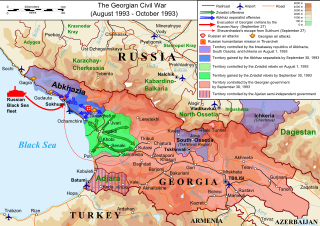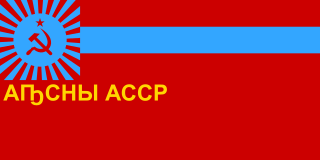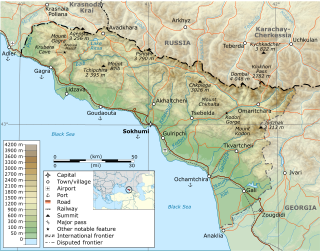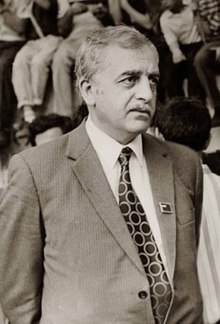
Zviad Konstantines dze Gamsakhurdia was a Georgian politician, human rights activist, dissident, professor of English language studies and American literature at Tbilisi State University, and writer who became the first democratically elected President of Georgia in May 1991.

The Transcaucasian Socialist Federative Soviet Republic, also known as the Transcaucasian Soviet Federative Socialist Republic, or simply Transcaucasia, was a republic of the Soviet Union that existed from 1922 to 1936.

The Georgian Soviet Socialist Republic, also known as Soviet Georgia, the Georgian SSR, or simply Georgia, was one of the republics of the Soviet Union from its second occupation in 1921 to its independence in 1991. Coterminous with the present-day republic of Georgia, it was based on the traditional territory of Georgia, which had existed as a series of independent states in the Caucasus prior to the first occupation of annexation in the course of the 19th century. The Georgian SSR was formed in 1921 and subsequently incorporated in the Soviet Union in 1922. Until 1936 it was a part of the Transcaucasian Socialist Federative Soviet Republic, which existed as a union republic within the USSR. From November 18, 1989, the Georgian SSR declared its sovereignty over Soviet laws. The republic was renamed the Republic of Georgia on November 14, 1990, and subsequently became independent before the dissolution of the Soviet Union on April 9, 1991, whereupon each former SSR became a sovereign state.

The Transcaucasian Democratic Federative Republic was a short-lived state in the Caucasus that included most of the territory of the present-day Armenia, Azerbaijan and Georgia, as well as parts of Russia and Turkey. The state lasted only for a month before Georgia declared independence, followed shortly after by Armenia and Azerbaijan.

The Georgian Civil War lasted from 1991 to 1993 in the South Caucasian country of Georgia. It consisted of inter-ethnic and international conflicts in the regions of South Ossetia and Abkhazia, as well as the violent military coup d'état against the first democratically-elected President of Georgia, Zviad Gamsakhurdia, and his subsequent uprising in an attempt to regain power.

The Abkhazia conflict is a territorial dispute over Abkhazia, a region on the eastern coast of the Black Sea in the South Caucasus, at the intersection of Eastern Europe and Western Asia. The conflict involves Georgia, Russian Federation and Russian-backed self-proclaimed Republic of Abkhazia, internationally recognised only by Russia, Venezuela, Nicaragua, Nauru, and Syria; Georgia and all other United Nations members consider Abkhazia a sovereign territory of Georgia. However, as of 2023, Georgia lacks de facto control over the territory.
For articles related to Georgia, see Category:Georgia (country)

The Mountainous Republic of the Northern Caucasus (MRNC), also referred to as the United Republics of the North Caucasus, Mountain Republic, or the Republic of the Mountaineers, was a state in Eurasia and encompassing the entirety of the North Caucasus that emerged during the Russian Civil War and existed from 1918 to 1919. It formed as a consolidation of various Caucasian ethnic groups, including the Abkhazians, Abazins Circassians, Chechens, Karachays, Ossetians, Balkars, Ingush, and Dagestanis.

The Mingrelians are an indigenous Kartvelian-speaking ethnic subgroup of Georgians that mostly live in the Samegrelo-Zemo Svaneti region of Georgia. They also live in considerable numbers in Abkhazia and Tbilisi. In the pre-1930 Soviet census, the Mingrelians were afforded their own ethnic group category, alongside many other ethnic subgroups of Georgians.

The Confederation of Mountain Peoples of the Caucasus was a militarised political organisation in the Caucasus, active around the time of before the collapse of the Soviet Union and after, between 1989 and 2000. It played a decisive role in the 1992–1993 war between Abkhazia and Georgia, rallying militants from the North Caucasian republics. Its forces have been accused by Georgia of committing war crimes, including the ethnic cleansing of Georgians. The Confederation has been inactive since the assassination of its second leader, Yusup Soslanbekov, in 2000.

The history of Abkhazia, a region in the South Caucasus, spans more than 5,000 years from its settlement by the lower-paleolithic hunter-gatherers to its present status as a partially recognized state.

The Abkhaz Autonomous Soviet Socialist Republic, abbreviated as Abkhaz ASSR, was an autonomous republic of the Soviet Union within the Georgian SSR. It came into existence in February 1931, when the Socialist Soviet Republic of Abkhazia, originally created in March 1921, was transformed to the status of Autonomous Soviet Socialist Republic within the Georgian SSR.

The Socialist Soviet Republic of Abkhazia was a short-lived republic within the Caucasus region of the Soviet Union that covered the territory of Abkhazia, and existed from 31 March 1921 to 19 February 1931. Formed in the aftermath of the Red Army invasion of Georgia in 1921, it was independent until 16 December 1921 when it agreed to a treaty that united it with the Georgian Soviet Socialist Republic. The SSR Abkhazia was similar to an autonomous Soviet republic, though it retained nominal independence from Georgia and was given certain features only full union republics had, like its own military units. Through its status as a "treaty republic" with Georgia, Abkhazia joined the Transcaucasian Soviet Federative Socialist Republic, which united Armenian, Azerbaijani, and Georgian SSRs into one federal unit when the latter was formed in 1922. The SSR Abkhazia was abolished in 1931 and replaced with the Abkhaz Autonomous Soviet Socialist Republic within the Georgian SSR.
The Sukhumi riot was a riot in Sukhumi, Abkhaz Autonomous Soviet Socialist Republic, Georgian Soviet Socialist Republic, Soviet Union, in July 1989, triggered by an increasing inter-ethnic tensions between the Abkhaz and Georgian communities and followed by several days of street fighting and civil unrest in Sukhumi and throughout Abkhazia.

Foreign relations exist between Armenia and Georgia. Both countries were former Soviet republics of the Soviet Union. Both countries' governments have had generally positive relations, but there have also been some problems.

The history of the Caucasus region may be divided by geography into the history of the North Caucasus (Ciscaucasia), historically in the sphere of influence of Scythia and of Southern Russia, and that of the South Caucasus in the sphere of influence of Persia, Anatolia, and Assyria.

The Declaration of Independence of Azerbaijan is the pronouncement adopted by the Azerbaijani National Council meeting in Tiflis on 28 May 1918, declaring the independence of the Azerbaijan Democratic Republic.

The Abkhazia–Georgia separation line is a de facto boundary set up in aftermath of the War in Abkhazia and Russo-Georgian War, which separates the self-declared Republic of Abkhazia from the territory controlled by the Government of Georgia. Republic of Abkhazia, and those states that recognise its independence, view the line as an international border separating two sovereign states, whereas the Georgian government and most other countries refer to it as an 'Administrative Border Line' within Georgian territory. The Georgian government views Abkhazia as a Russian-occupied Georgian territory and designates the de facto boundary as an occupation line in accordance with the Georgian "Law on Occupied Territories of Georgia". The Constitution of Georgia recognizes Abkhazia as autonomous within Georgia, therefore the line corresponds to the 'Administrative Border' of the Autonomous Republic of Abkhazia within Georgian territory.

The Georgia–South Ossetia separation line is a de facto boundary set up in aftermath of the 1991–1992 South Ossetia War and Russo-Georgian War, which separates the self-declared Republic of South Ossetia from the territory controlled by the Government of Georgia. South Ossetia, and those states that recognise its independence, view the line as an international border separating two sovereign states, whereas the Georgian government views it as an occupation line in accordance with the Georgian "Law on Occupied Territories of Georgia". The Constitution of Georgia does not recognize South Ossetia as having any special status within Georgia, therefore the line does not correspond to any Georgian administrative area, with the territory claimed by the Republic of South Ossetia shared out amongst several Georgian Mkhares: Shida Kartli, Imereti, Racha-Lechkhumi and Kvemo Svaneti and Mtskheta-Mtianeti.
Musa Magomedovich Shanibov, born Yuri Mukhamedovich Shanibov and also known simply as Musa Shanib, was a Circassian politician and revolutionary who led the Confederation of Mountain Peoples of the Caucasus from its founding until 1996. Popularly known as the "Garibaldi of the Caucasus", Shanibov led a largely-unsuccessful campaign for the region's nations to achieve independence from Russia and commanded volunteer troops in both the 1992–1993 War in Abkhazia. He was involved in the ethnic cleansing of Georgians in Abkhazia.

















